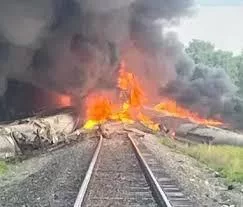
BORDULAC, N.D. (NewsDakota.com/KFGO) – The fiery train derailment near Bordulac on July 5, which burned for days, is the latest incident involving the flawed DOT-111 tank cars that the National Transportation Safety Board (NTSB) has been pushing to remove from service for decades.
In a preliminary report released Thursday, the NTSB estimated that the crash caused $3.6 million in damages to CPKC railroad tracks and equipment. However, the agency did not provide many clues about what led to the early morning derailment.
CPKC railroad officials are barred from commenting on the incident while the NTSB investigation is ongoing.
The NTSB noted that some of the 17 tank cars carrying hazardous materials that derailed were DOT-111 tank cars, which have repeatedly been shown to rupture in crashes. The agency has been recommending the elimination of these cars for hazardous materials since the 1990s, and Congress has mandated their replacement for hauling flammable liquids by 2029. Despite this, DOT-111 cars can still be used for other hazardous materials.
The Federal Railroad Administration has indicated that it might be possible to move up this deadline by a year, though tank car manufacturers currently lack the capacity to accelerate the timeline significantly. Replacing these tank cars also poses a substantial cost to the chemical and leasing companies that own them.
The NTSB plans to conduct a detailed damage assessment of both the DOT-111 tank cars and the more robust newer models involved in this crash as part of its investigation, which could take a year or more. The DOT-111 tank cars previously exacerbated the Norfolk Southern derailment in East Palestine, Ohio, last year, where their rupture and subsequent spill of butyl acrylate led to a massive fire.
In the North Dakota crash, only two homes were voluntarily evacuated for two days while crews extinguished fires and managed spills of methanol and anhydrous ammonia. A dozen other derailed cars were carrying plastic pellets. Fortunately, no injuries were reported.
The NTSB mentioned that an emergency brake application was made before the train derailed but did not specify if it was initiated by the two-person crew or automatically triggered. The 151-car train was traveling at about 45 mph at the time of the derailment, under the 50 mph speed limit for trains carrying hazardous materials.
